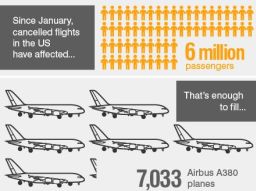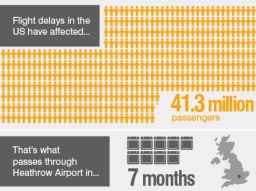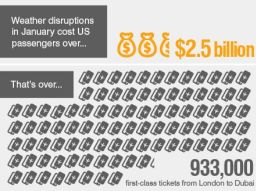Story highlights
Bad weather has caused an historic number of flight cancellations and delays in and out of U.S.
Cancellations and delays cost passengers $2.5 billion in 2014 so far
They've cost airlines an additional $75m to $150m
Though we’re still in the early stages of 2014, it is already proving one of the most expensive years for the travel industry.
According to masFlight, an enterprise software company that crunches big data for the transport and logistics sectors, January’s bizarre weather patterns have already cost passengers flying into and out of the U.S. $2.5 billion, and airlines between $75m and $150m because of canceled and delayed flights.
“It’s not easy for an airline to recoup losses resulting from an aircraft being delayed or canceled,” says Tulinda Larsen, masFlight’s vice president of business development. “The cost of pilots that don’t take off, the crew overtime, reimbursing tickets – those costs aren’t easy to make up.”
For passengers, a plane stuck on the tarmac can cost more than aggravation and the price of a ticket. Even with a refund, stranded fliers are stuck with the bill for hotel rooms, taxis, rental cars, food and other unanticipated expenses.


“On average, a canceled flight takes a passenger an additional 18 hours of travel time to get to their destination,” Larsen explains.
“During that time, they’re going to incur costs they weren’t anticipating, costs the airlines don’t have a responsibility to cover, so that passengers are going to be out of pocket.”
According to flight-tracking website FlightAware, this has been the worst year on record for cancellations in the US. Since December 1, 2013, nearly 90,000 flights have been canceled.
“Domestically, it’s been a terrible year. By the end of January, we’ve has as many cancellations as we usually see through mid-April,” says Mark Duell, FlightAware’s vice president of operations.

Regional airlines were the most affected by the weather, though none as severely as JetBlue, which saw its revenue for January reduced by $45 million.
“While we generally have a strong ability to recapture revenue when we cancel flights during weather events by re-accommodating, our re-booking options for our customers during this high-traffic period were very limited,” admits JetBlue spokeswoman Tamara Young.
According to Larsen, however, the weather in-and-of itself wasn’t what grounded millions of flyers, but the airline’s capacity to handle them.
Larsen blames two government regulations for the issue, the first issued by the U.S. Department of Transportation delaying the amount of time a plane is allowed to stay on the tarmac to three hours (and imposing $27,500 in fines for carriers that don’t comply), and the second is a restriction on how long pilots can remain on duty.
“Those are two artificial policy restraints that airlines are working with operationally,” she says.
Another issue is airlines stuffing planes to capacity, meaning when there are cancellations or delays, there is less flexibility in booking passengers on an alternative flight.
“Load factor is the highest it’s been in history. It’s not easy to re-accommodate passengers a couple of days later,” Duell notes.
Given the likelihood that this year’s bizarre weather patterns are possibly a result of climate change, and could become less of an anomaly and more the norm, one wonders how airlines are prepared to adjust in future years. Duell recons one bad winter won’t be enough to spur airlines to action.
“No one will look at one winter and decide to spend a lot of money they don’t have,” he says.
“But I think if we see a lot of bad winters in a row, airlines will invest in more tools, processes, and procedures to help them recover.”
